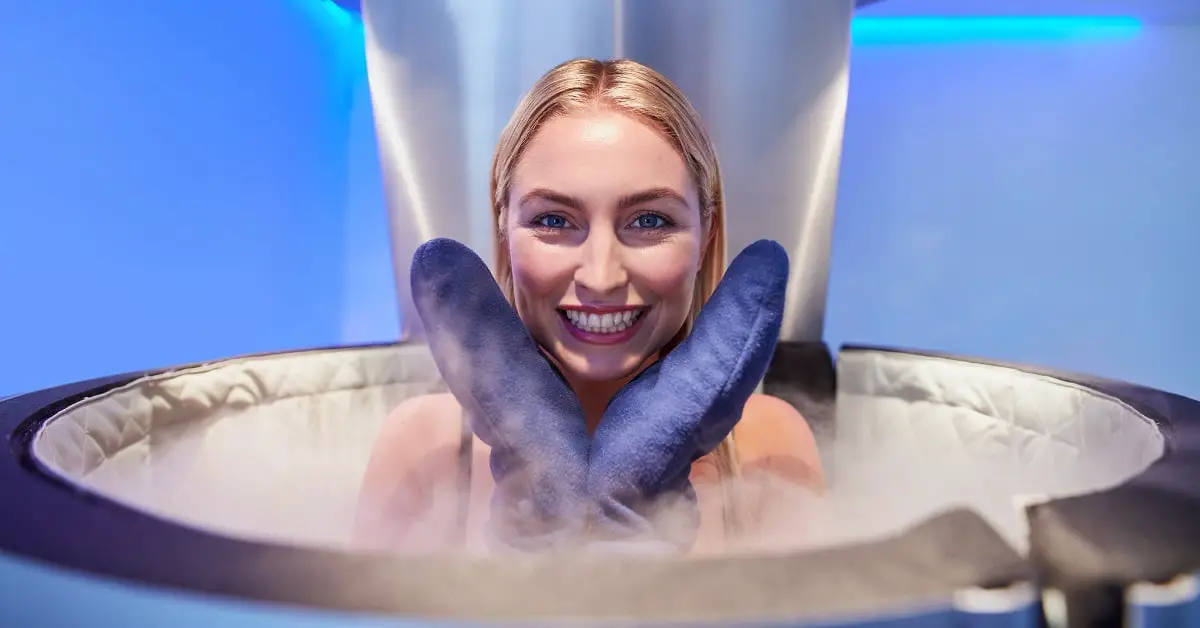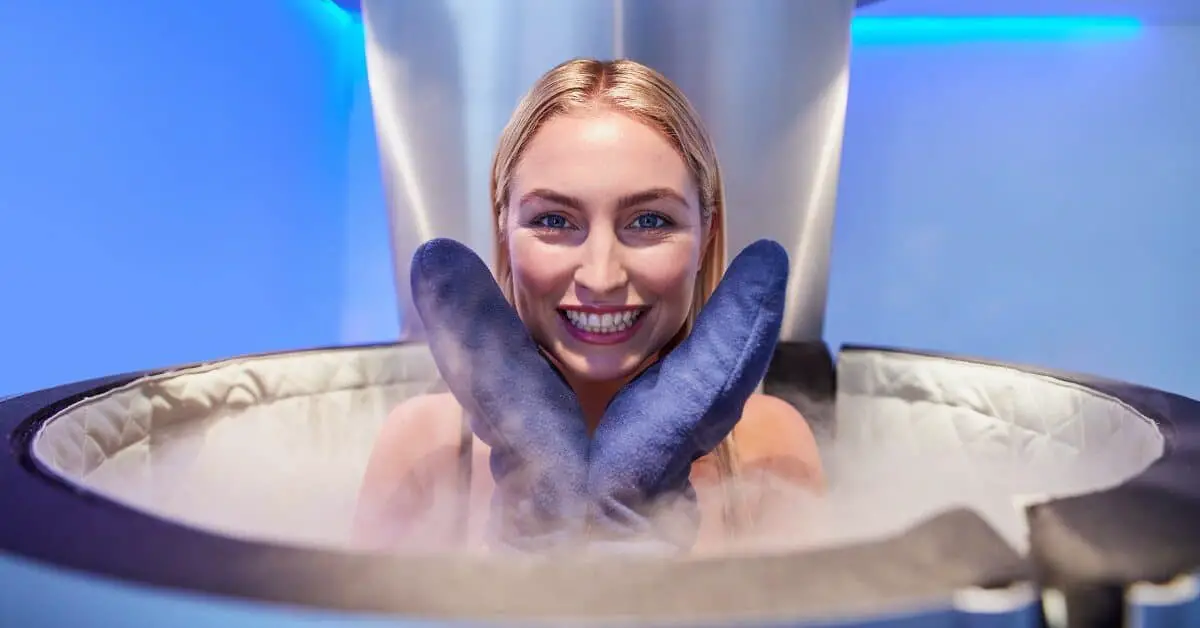
Cryotherapy, also known as cold therapy, has become popular in recent years due to claims of various health benefits.
Many people weighing their options for weight loss and fat reduction want to know whether cryotherapy helps.
This article answers your questions about whether cryotherapy and coolsculpting (cryolipolysis) work for weight loss and fat reduction (read: Does cryotherapy help with weight and fat loss?; read: Does coolsculpting work?).
We include links to 21 coolsculpting before and after photos (click the link to view the list) for the benefit of readers who want visual evidence of the effectiveness of the procedure.
The photos are sourced from peer-reviewed journals and likely give a more realistic picture of what to expect.
If you are unfamiliar with terms such as cryotherapy, coolsculpting, and cryolipolysis we give in-depth answers (see list of contents below).
We also explain the differences between whole-body cryotherapy, partial-body cryotherapy, cryolipolysis, and coolsculpting.
Contents:
What is cryotherapy?
Types of cryotherapy procedures
–Whole-body cryotherapy
–Partial-body cryotherapy
–Localized cryotherapy
Coolsculpting (cryolipolysis) fat freezing
Cryotherapy vs. coolsculpting (cryolipolysis)
Does cryotherapy help with weight and fat loss?
–Does cryotherapy work on belly fat?
–Does cryotherapy work for fat loss?
–Does cryotherapy burn calories?
Does coolsculpting work?
–Do you lose weight from coolsculpting?
–Coolsculpting for fat reduction
–Does coolsculpting work on belly fat?
–Does coolsculpting work on armpit and chin fat?
–Alternating cold and heat treatment
21 coolsculpting before and after photos
How does coolsculpting (cryolipolysis) work?
Coolsculpting long-term results
Cryolipolysis (coolsculpting) side effects and safety
What is cryotherapy?

Cryotherapy, also known as cold therapy, involves exposure to extremely cold or freezing temperatures for various health and medical benefits.
Fontana and associates (2022) reported that cryotherapy involved exposing the whole body or part to low temperatures for 2-to-3-minutes.
According to the FDA, whole-body cryotherapy (WBC) temperatures may be as low as -200°F to -300 °F (-130°C to -185°C).
According to Costello and associates (2012), temperatures of -110°C to -140°C (-166°F to -220°F) were the range most commonly used for whole-body cryotherapy (WBC).
Hohenauer and associates (2020) reported using a temperature of -135°C for partial-body cryotherapy.
The FDA defined cryotherapy as “supercooling” the body for therapeutic purposes, such as relieving acute and chronic muscle pain, migraine headaches, and inflammatory conditions.
Cryotherapy (also known as cryostimulation) enhanced post-exercise muscle recovery and relieved exercise-induced muscle damage (Codella et al., 2020; Hohenauer et al., 2020).
It also freezes, destroys, and removes unwanted or diseased tissues, such as pre-cancerous and cancerous tissues (the procedure is known as cryoablation).
Cryotherapy also treats skin conditions — such as warts, tags, and eczema — by freezing and destroying unwanted tissues.
Types of cryotherapy procedures
There are different types of cryotherapy procedures. This article covers the following:
- Whole-body cryotherapy
- Partial-body cryotherapy
- Cryolipolysis or coolsculpting involve the local application of cold or freezing temperature to destroy unwanted tissues
Whole-body cryotherapy
The use of whole-body cryotherapy (WBC) dates back to the 1980s. The procedure first became popular in European countries, such as Germany, Austria, Finland, Poland, and Russia (Filliard et al., 2016).
According to Roszkowska and co-workers (2018), whole-body cryotherapy (also known as full-body cryotherapy) involves cooling the entire body (below −100°C) for a few minutes in a sealed room known as a cryochamber.
The patient sits or stands in the cold tank or chamber for a few minutes (typically 3-5 minutes). The tank encloses their entire body (including the head) (see YouTube below).
Fontana and associates (2022) also described whole-body cryotherapy (WBC) as exposing the whole body to low temperatures in a cryochamber (see also Bouzigon et al., 2016).
Partial-body cryotherapy
In partial-body cryotherapy (PBC), the patient typically sits or stands in an open tank (cryosauna) that covers the body up to the arms or shoulders (see YouTube below).
You may enter a cryosauna or a cryochamber wearing only your undies or protective covering over cold-sensitive body parts, such as the ears and body extremities (hands and feet).
In partial-body cryotherapy, temperatures are as low as -166°F to -222 °F (-110°C to -141°C).
Cooling is done electrically or by using liquid nitrogen, nitrous oxide, or argon gas.
Fontana and associates (2022) also described partial-body cryotherapy (WBC) as exposing the body (excluding the head) to ultra-low temperatures.
Localized cryotherapy
Cryotherapy does not always require the use of a closed or open chamber.
It may involve the local application of low temperatures to freeze or destroy abnormal or unwanted tissues.
The target tissue may be a skin condition, abnormal tissue, or an unwanted blemish (eczema, psoriasis, dermatitis, tags, and warts).
The target may also be beneath the skin (subcutaneous fat) or a cancerous growth inside the body.
A probe may help reach target tissues inside the body.
Cryolipolysis (also known as coolsculpting) is a localized or targeted cryotherapy procedure for removing fat through freezing.
The procedure involves the local application of cold temperatures to freeze, destroy, and remove fat cells and tissues (adipocytes).
Coolsculpting (cryolipolysis) fat freezing
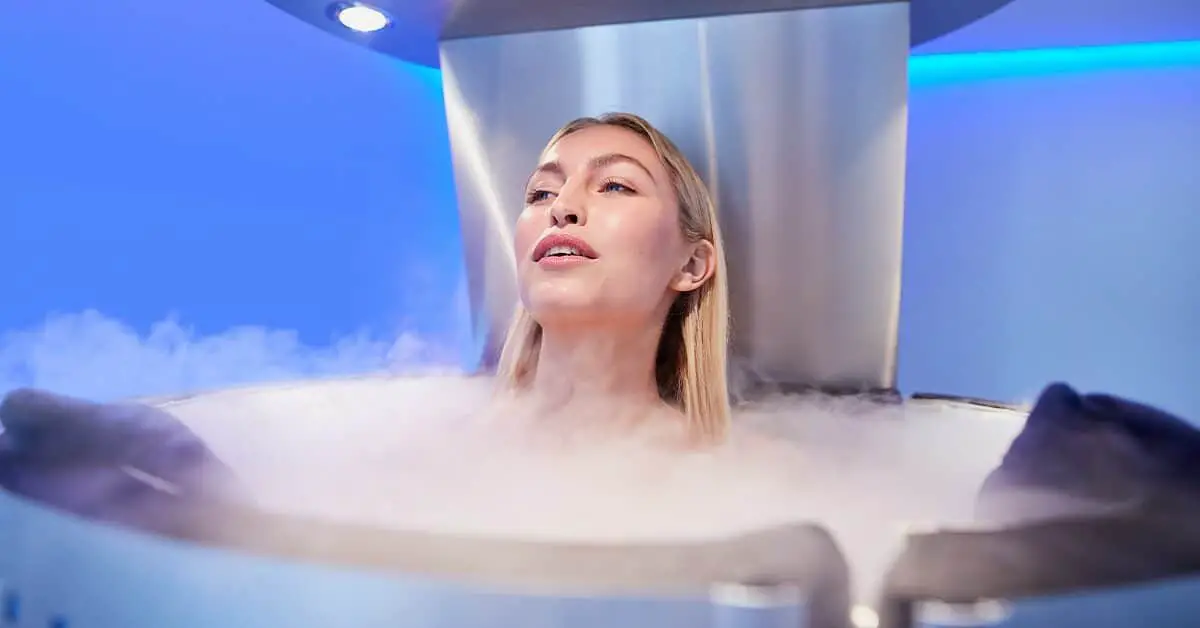
Cryolipolysis or coolsculpting is a body contouring procedure that involves applying extreme cold to the body to induce lipolysis (death or breakdown of fat) (Few et al., 2020).
[Note: Coolsculpting is a brand name for cryolipolysis. This article henceforth uses the terms interchangeably.]
The procedure received FDA approval for fat reduction in the abdomen, flanks, and thighs (Kilmer et al., 2016).
[Note: Body contouring (also known as body sculpting) refers to various procedures used to remove fat and reshape the body, eliminate extra skin, and tighten loose skin after significant weight loss.]
According to Meyer and colleagues (2016), cryolipolysis is a noninvasive procedure for localized fat reduction. It involves controlled cold exposure to achieve selective destruction of fat cells.
Altmann and co-workers (2022) reported that cryolipolysis is an increasingly popular nonsurgical fat-reduction procedure used as an alternative to liposuction and other invasive and surgical fat removal techniques.
The procedure freezes subcutaneous fat cells through controlled cooling that induces cell death (apoptosis) and subsequent elimination from the body.
Coolsculpting freezes and destroys subcutaneous fat by cooling it to a target temperature of between 30.2℉ and 39.2℉ (-1℃ to 4℃). The cooling session may last up to an hour.
The destruction (apoptosis and necrosis) of fat cells leads to breakdown and loss of fat over several weeks following the treatment.
Cryotherapy vs. coolsculpting (cryolipolysis)
Cryolipolysis involves the local application of extreme cold or freezing temperatures. The procedure targets adipocytes for destruction but spares other surrounding tissues, such as skin, nerves, vessels, and muscles.
Loap and Lathe (2018) considered cryolipolysis to be a specific application of the principle of cryotherapy. Thus, they described cryolipolysis as “targeted cryotherapy” or “tissue cryotherapy.”
By that, they meant that coolsculpting was a type of cryotherapy involving localized application of cold temperature for a specified time to reduce subcutaneous fat.
The authors explained that local application of cold or freezing temperatures induced subcutaneous fat tissue disruption, inflammation (panniculitis), and death (“cryolipolysis”).
[Note: The word “cryolipolysis” comes from Greek words meaning “cold-induced fat breakdown.”]
Manstein and associates 2008 were the first researchers to formally describe the “cryosurgical” method in a paper published in 2008 (see Ingargiola et al., 2015).
The authors noted that healthcare providers used cryotherapy for non-specific or non-targeted tissue destruction. They then suggested using the procedure (“selective cryolysis”) for targeted or selective destruction of subcutaneous fat tissue.
Manstein and associates (2008) experimented by exposing Black Yucatan pigs under general anesthesia to temperatures of 20℃, -1℃, -3℃, -5℃, and -7℃ for 10 minutes.
[Note that the temperatures used in coolsculpting are significantly higher than the ultra-low temperatures (-166°F to -300℉) used in partial-body and whole-body cryotherapy.]
The authors assessed the effects of low-temperature exposure on days 1, 2, 7, 14, 28, and 3.5 months after the exposure.
The researchers also exposed 15% of the total body surface of another set of pigs to temperatures between -5℃ and -8℃ for 10 minutes.
They took the serum lip levels of the animals at different points in time for up to 3 months.
Manstein and associates (2008) reported that local cooling caused lobular panniculitis (inflammation of subcutaneous fat tissue) in the animals.
Lobular panniculitis led to a gradual loss of subcutaneous fat over 3.5 months. The authors also reported no signs of skin injury or scarring in most cases.
They concluded that prolonged and controlled application of cold temperatures to the skin induced selective damage (“selective cryolysis”) and loss of subcutaneous fat without damage to the overlying skin.
Does cryotherapy help with weight and fat loss?

Several recent studies suggest that cryotherapy may help with weight loss.
Does cryotherapy work on belly fat?
A study by Wiecek and associates (2020) concluded that whole-body cryotherapy (WBC) was effective in reducing belly fat (abdominal obesity) in menopausal women with cardiometabolic syndrome.
According to the authors, abdominal obesity was common among menopausal women and predisposed to cardiometabolic syndrome.
Cardiometabolic syndrome is associated with cardiovascular disease, diabetes, fatty liver disease, and increased mortality.
The study assessed the effects of whole-body cryotherapy (WBC) on body composition in 19 women with cardiometabolic syndrome (age: 61.53 ± 3.99 years; BMI: 30.09 ± 4.98 kg/m2) and 18 healthy women (age: 60.28 ± 3.63years; BMI: 25.50 ± 2.37 kg/m2).
The subjects were exposed to whole-body cryotherapy treatment at −130 °C for 3 minutes daily for 20 days.
The researchers reported that after 20 treatments, both groups experienced a significant decrease in the measures of body composition, such as abdominal circumference, body mass, body mass index (BMI), triceps skinfold, and total fat mass.
The subjects also recorded decreases in waist circumference (WC) and waist-to-height ratio (WHtR).
The group with cardiometabolic syndrome experienced a significant decrease in android fat (fat in the trunk and upper body).
The healthy group recorded a significant decrease in hip circumference and abdominal skinfold.
The researchers concluded that whole-body cryotherapy reduced belly fat (abdominal obesity) in menopausal women. They added that it could be an effective adjunctive therapy for cardiometabolic syndrome in menopausal women.
Does cryotherapy work for fat loss?
Fontana and associates (2022) conducted a systematic review of studies on the effectiveness of whole-body cryotherapy (WBC) for fat loss and treating obesity.
Based on 8 studies that met their criteria for methodological quality, the researchers concluded that research appeared to support the efficacy of WBC as adjuvant therapy for obesity.
[Note: An adjuvant therapy is a secondary therapy that enhances the potency or efficacy of the primary.]
But they added that while studies suggested that WBC may play a role as adjuvant therapy for fat loss, reducing body mass, abdominal obesity, oxidative stress, and systemic inflammation, the data was inconclusive.
Hag and associates (2022) also reported that repetitive whole-body cryotherapy (WBC) induced a significant reduction in body fat percentage in male athletes.
Does cryotherapy burn calories?
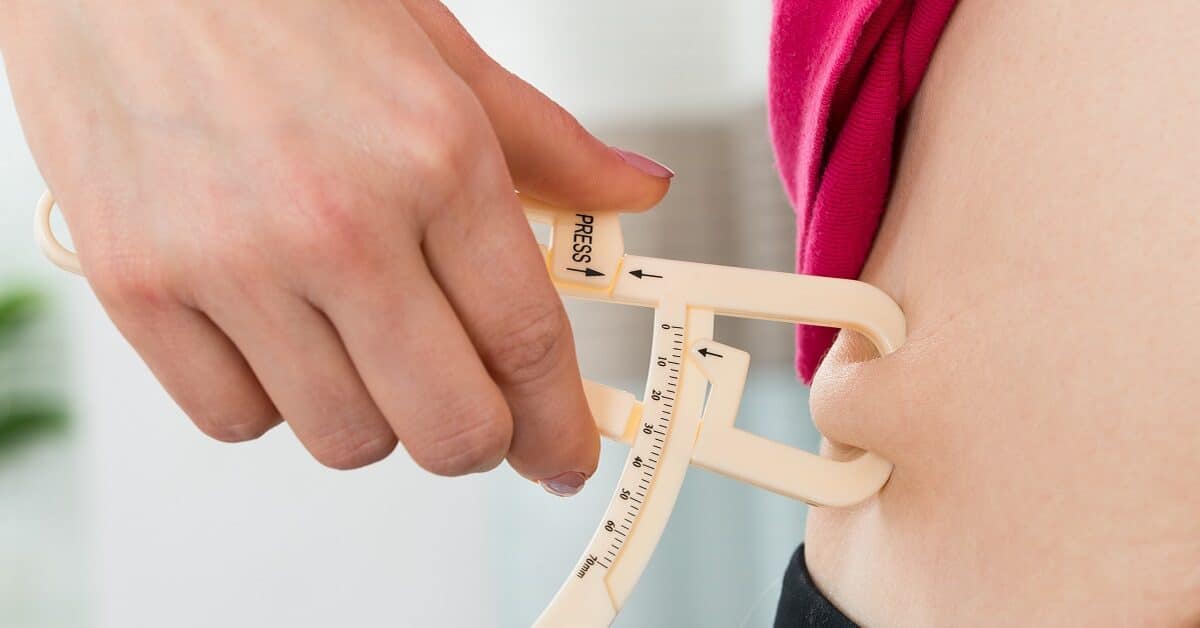
Yes, cryotherapy burns calories by boosting metabolism (sauna heat therapy also burns calories).
Codella and co-workers (2021) reported that partial-body cryotherapy (PBC) could be an alternative way to trigger cold-induced thermogenesis in overweight/obese subjects.
Thermogenesis increases calories burned by boosting resting metabolic rate (RMR). The boost leads to increased fat metabolism, fat reduction, and weight loss.
The study involved 16 overweight women (age: 43.4±4.8 years; BMI 32±4 kg/m2) who underwent a partial-body cryotherapy session daily (-130°C for 150 secs) for 5 days.
The authors measured resting metabolic rates (RMR) (using indirect calorimetry) before and after PBC sessions on days 1 and 5. They found that RMR had increased by 5.5% before treatment on the 5th day compared to before treatment on the 1st day.
In another sample of 80 subjects (male (n)=19; female (n)=61; age=34.4±11.1 years; BMI=24.4±4.8 kg/m2), RMR increased by 1.89% after PBC on day 1.
The authors concluded that the preliminary data suggested cold therapy induced thermogenesis and that it may play a role as an alternative therapy for weight loss and combating overweight and obesity.
Nardi and associates (2021) reported that cryotherapy (cryostimulation) was a potential adjuvant therapy for combating obesity and dysmetabolism (cardiometabolic syndrome).
The authors suggested it worked through inducing thermogenesis (cold-induced thermogenesis).
They investigated the effects of single and repeated partial-body cryotherapy (PBC) on resting metabolic rate (RMR).
The study involved 15 obese middle-aged obese women (body mass index: 31 ± 1.6 kg/m2) and sixteen lean women (BMI: 22 ± 1.7 kg/m2). Both groups underwent partial-body cryotherapy (−130 °C for 150 secs) daily for five consecutive days.
The researchers measured resting metabolic rates (RMR) using indirect calorimetry before and after PBC on days 1 and 5.
They found that RMR increased from day 1 to day 5 in both groups, with the obese group recording a higher increase (8.2%) compared to the lean group (5.5%).
The researchers concluded that cryotherapy could play a role in weight and fat reduction by boosting metabolism in obese individuals.
Research studies have shown multiple related health benefits of cryotherapy in obese people.
Ziemann and associates (2013) concluded that WBC may help reduce low-grade inflammation in obese men.
Studies show that sauna exposure also burns calories. Find out how many calories you burn during a sauna session.
How does cryotherapy work?
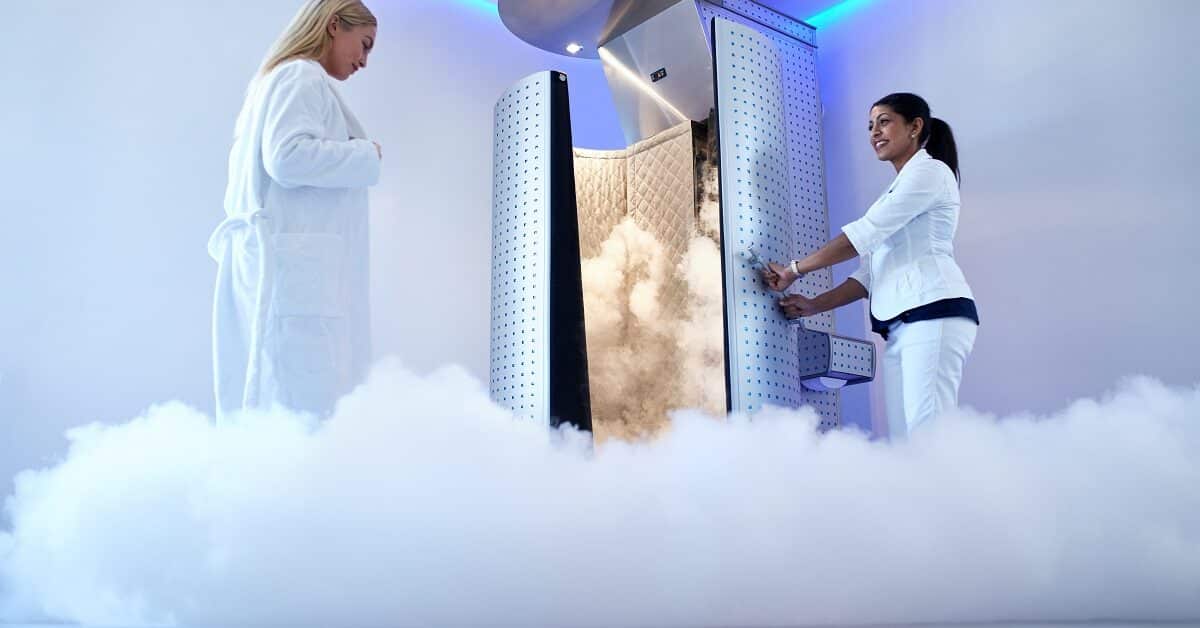
Loap and Lathe (2018) identified two possible mechanisms through which whole-body and partial-body cryotherapy may induce weight and fat loss.
They noted that the most widely accepted view was that cryotherapy involved “acute cooling” of adipose (fat tissues).
The cooling induced disruption and inflammation of adipocyte cells, leading to adipocyte cell death (lipolysis).
The death of adipocyte cells was accompanied by the loss of subcutaneous fat over several weeks and months, leading to fat and weight loss.
The second suggested mechanism was that cryotherapy caused increased fat metabolism through cold-induced thermogenesis or cryothermogenesis (learn more about thermogenesis here).
The authors conducted a study to determine which of the two mechanisms was the cause of cryotherapy-induced fat and weight loss.
They concluded that cryotherapy-induced thermogenesis (“cryothermogenesis”) rather than disruption, death, and inflammation caused the loss of adipose tissue.
The authors recommended further studies to assess the safety and effectiveness of cryotherapy for treating obesity and overweight.
Does coolsculpting work?
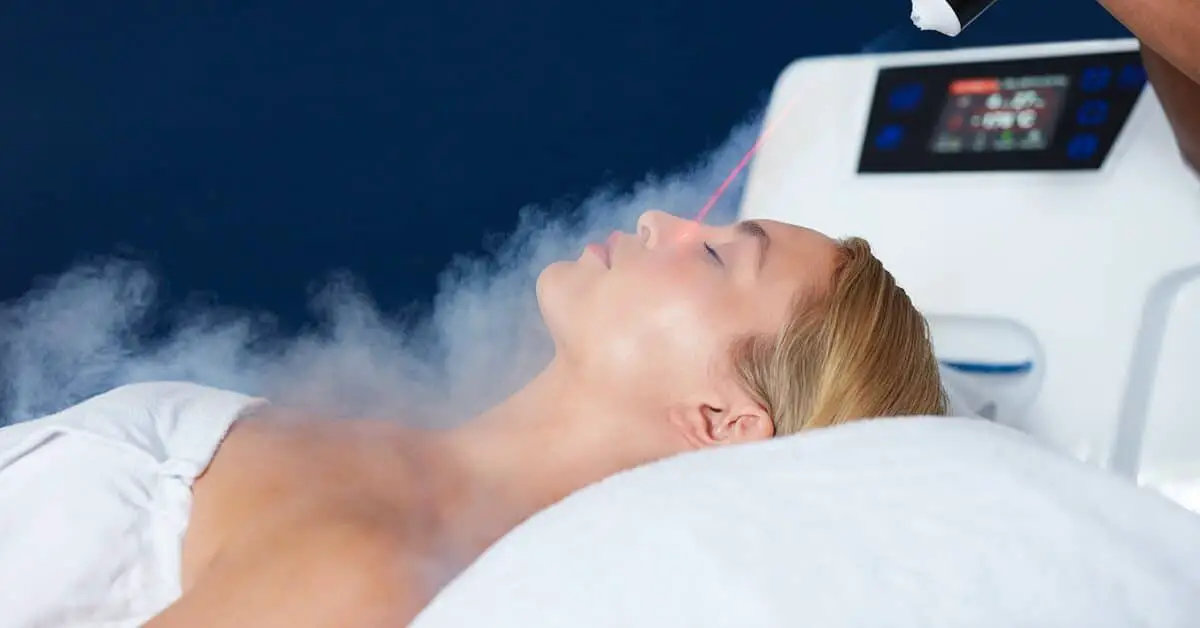
Several recent studies demonstrated that coolsculpting (cryolipolysis) was effective for fat reduction and weight loss.
Do you lose weight from coolsculpting?
Laop and Lathe (2018) reported that “tissue cryotherapy” or targeted cryotherapy (also known as cryolipolysis or coolsculpting) was effective for combating overweight and obesity.
The researchers reported that measurements of body weight, waist circumference, BMI, and whole-body dual-energy X-ray absorptiometric scanning showed that a single session of tissue cryotherapy caused significant loss of fat tissue.
Coolsculpting for fat reduction
According to Krueger and colleagues (2014), clinical studies showed that coolsculpting reduced subcutaneous fat by up to 25% after only one treatment. The researchers also reported that 86% of subjects reported improvement, while 73% reported satisfaction.
Does coolsculpting work on belly fat?
Hwang and colleagues (2020) reported that coolsculpting was a widely-used noninvasive alternative to surgical procedures for reducing body fat.
The authors conducted a split body trial to assess changes in belly fat (visceral or abdominal fat) 12 weeks after cryolipolysis.
In a split-body trial involving 15 subjects, the authors assessed the effect of a single session of unilateral (treatment of only one side of the body) cryolipolysis on visceral and subcutaneous adipose (fat) tissue.
Only the left abdomen of the subjects underwent cryolipolysis treatment, allowing the right side to be a control.
The authors took waist circumference and percent body fat measurements before performing the procedure. They repeated the measurements 6 and 12 weeks after the treatment.
They reported a significant decrease in belly fat, waist circumferences, and percent body fat in the treated section compared with the untreated.
Ingargiola and colleagues (2015) concluded that cryolipolysis was an effective nonsurgical technique for localized fat reduction and a promising alternative to nonsurgical body contouring.
Meyer and co-workers (2016) investigated the effectiveness of coolsculpting in eliminating belly fat.
The subject was a 46-year-old female with localized belly fat (abdominal fat). She underwent 60 minutes of cold therapy (−5°C) in the hypogastrium (the region below the navel or umbilicus).
Ultrasound image analysis on days 7, 15, 30, and 45 after treatment confirmed significant destruction and reduction of subcutaneous fat tissue. Examination of tissues removed by an abdominoplasty (“tummy tuck” surgery) supported the ultrasound evidence.
Does coolsculpting work on armpit and chin fat?
Kilmer and associates (2015) reported that healthcare providers used coolsculpting for fat reduction in the abdomen, flanks, and thighs.
They also used the procedure for fat reduction beneath the chin (submental), back, knees, underarm, and armpit region (axilla).
Clinical evaluation of 60 patients who had undergone the procedure to remove chin fat concluded it was safe and effective.
It resulted in a visible improvement in the appearance of the chin and neck, and patients reported satisfaction with the results.
Alternating cold and heat treatment
Savacini and associates (2018) investigated the effectiveness and safety of contrast cryolipolysis for subcutaneous-fat reduction.
According to the authors, contrast cryolipolysis is a noninvasive method for treating localized fat that involves alternating cryolipolysis (coolsculpting) with heating.
The study involved 21 subjects (aged 34 ± 9 years). They received contrast cryolipolysis treatment in the abdomen and flanks.
The treatment involved repeatedly exposing the subcutaneous-fat layer in the abdomen and flanks to heat at 40 °C for 10 minutes before cooling to −8°C for 60 minutes.
To assess the effects of the treatment, the researchers took anthropometric data (weight and height), photographs, and measurements (such as skinfold caliper).
They also did diagnostic ultrasounds before treatment and 30, 60, and 90 days after.
They reported a significant reduction in waist measurement after 30, 60, and 90 days. They also found a reduction in skinfold and ultrasound measurements in all treated areas.
The researchers concluded that contrast cryolipolysis was safe and effective for reducing fat and improving body contouring.
You may learn about the benefits of sauna heat therapy here.
21 coolsculpting before and after photos
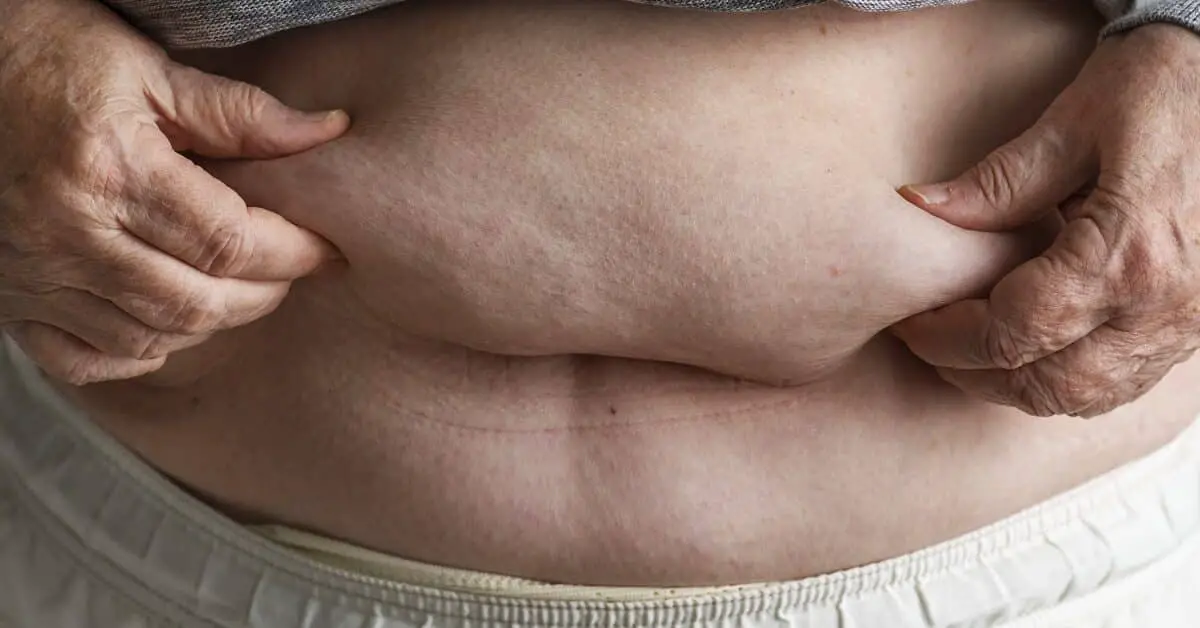
We provide links to 21 coolsculpting before and after photos for readers who want reliable visual evidence of what to expect from the procedure.
We sourced the photos from peer-reviewed journals because we believe photos from peer-reviewed journals likely give a more realistic picture of what to expect.
It is reasonable to assume that photos with more recent dates (2018-2022) reflect the state of the art compared with older ones.
Coolsculpting before and after stomach (belly fat)
Coolsculpting before and after stomach (click the link to view image): 42-year-old female with a baseline body mass index of 24.4 kg/m2 (Few et al., 2020)
Before and after stomach, flanks (“love handles”), and lower back: 59-year-old female with a baseline body mass index of 25 kg/m2 (Few et al., 2020)
Before and after stomach and flanks: 39-year-old female (Lee et al., 2018)
Stomach (abdomen): 58-year-old woman (McKeown and Payne, 2021)
Stomach (abdomen): 27-year-old female (Stevens et al., 2013)
Stomach(abdomen): 59-year-old female (Stevens et al., 2013)
Coolsculpting arms before and after
Coolsculpting arms before and after (click the link to view photo): 20-year-old female (Lee et al., 2018)
Underarm before and after: 58-year-old female with a baseline body mass index of 25 kg/m2 (Few et al., 2020)
Upper arms before and after: 58-year-old woman (McKeown and Payne, 2021)
Arms before and after: Baseline, 3 and 6 months follow-up photos (Wanitphakdeedecha et al., 2015)
Coolsculpting chin before and after
Coolsculpting chin before and after (click the link to view photo): 36-year-old female with a baseline body mass index (BMI) of 24.8 kg/m2 (Few et al., 2020)
Chin before and after: Male patient pre-treatment and 12 weeks post-treatment (Bernstein and Bloom, 2017)
Chin before and after: Female patient pre-treatment and 12 weeks post-treatment (Bernstein and Bloom, 2017)
Before and after flanks (“love handles”)
Coolsculpting flanks (“love handles”) before and after (click the link to view photo): 42-year-old woman (McKeown and Payne, 2021)
Flanks (“love handles”) before and after (scroll down the page to view image slide): 45-year-old male (Bernstein, 2016)
Flanks (“love handles”): 58-year-old man (Stevens et al., 2013)
Right flank (“love handle”) (scroll down the page to view image slide): 55-year-old man (Bernstein, 2016)
Back fat before and after
Back fat before and after (click the link to view photo): 68-year-old woman (McKeown and Payne, 2021)
Thighs before and after
Thighs before and after (click the link to view photo): 39-year-old female (Stevens et al., 2013)
Thighs before and after: Baseline, 3 and 6 months follow-up (Wanitphakdeedecha et al., 2015)
Bra fat or “bra rolls”
Bra fat (“bra rolls”) (click the link to view photo): 58-year-old woman (Stevens et al., 2013)
Gynecomastia
Gynecomastia: 37-year-old man (Stevens et al., 2013)
How does coolsculpting (cryolipolysis) work?

Manstein and colleagues (2008) explained that cryolipolysis (also known as coolsculpting) worked because fat cells were more vulnerable to damage from cold temperatures than other cells, such as skin cells.
Cryolipolysis involved applying a low temperature (30.2℉ and 39.2℉) to a part of the body for a specified time (35 minutes to an hour), according to Ingargiola and co-workers (2015).
The application selectively destroyed the adipocytes (fat cells) but spared the skin, nerves, vessels, and muscles.
Krueger and colleagues (2014) also described cryolipolysis or coolsculpting as a noninvasive method for adipose tissue reduction. Other noninvasive methods included radiofrequency, low-level laser, and high-intensity focused ultrasound.
According to the authors, cryolipolysis caused the death (apoptosis or necrosis) of targeted adipocyte (fat) cells.
The researchers also explained that coolsculpting followed the principle that adipocyte cells were more susceptible to low temperatures than surrounding skin cells.
The localized application of low temperates caused the death of the adipocytes (lipolysis), resulting in an inflammatory reaction and digestion of necrotic tissue by macrophages.
Coolsculpting long-term results
Derrick and associates (2015) conducted a systematic review of scientific literature on cryolipolysis or coolsculpting to assess the efficacy and safety of the body contouring procedure.
Based on the results from 16 studies that matched their selection criteria, the researchers concluded that short-term follow-up indicated cryolipolysis reduced subcutaneous fat.
They recommended further studies to assess the long-term results of the procedure.
Bernstein (2016) followed up with 2 patients to assess the long-term effects of coolsculpting. The patients underwent the procedure on one flank while the other side was left untreated.
The researcher followed up with the patients after 6 years and 9 years, respectively, to assess long-term effects.
Comparison of treated and untreated flanks based on images taken immediately after the procedure and years later demonstrated long-term effectiveness and durability.
Cryolipolysis (coolsculpting) side effects and safety
Krueger and colleagues (2014) reported that coolsculpting was a safe method for body contouring.
Common side effects were minor and included transient pain, bruising, and erythema that usually resolved within 2 weeks after treatment.
The authors concluded that the procedure was safe and efficient.
Stevens and associates (2013) also concluded that coolsculpting was safe and effective.
Derrick and colleagues (2015) reported that short-term follow-up of patients who underwent cryolipolysis indicated that the procedure was safe.
They noted that complications were uncommon and that most adverse effects resolved without intervention. The researchers recommended further studies to establish the long-term safety and efficacy of the procedure.
According to Meyer and colleagues (2018), coolsculpting was safe and effective with high patient satisfaction rates compared with alternative procedures, such as high-intensity focused ultrasound and shock waves.
Ingargiola and associates (2015) conducted a systematic review of clinical data on the efficacy, safety, and complications of cryolipolysis.
The authors described coolsculpting as a nonsurgical technique for fat reduction. The procedure may provide a nonsurgical alternative with a lower risk of complications compared with invasive methods, such as liposuction.
After reviewing 19 studies that assessed the outcomes of cryolipolysis, they concluded it significantly reduced fat without affecting liver function tests or lipid levels.
The authors reported that the procedure only caused mild, short-term effects, including erythema (reddening due to irritation or injury), local swelling, numbness, and pain.
One patient experienced paradoxical adipose hyperplasia (adipose tissue enlargement due to cell proliferation).
The adverse effects were mild compared with other procedures such as liposuction.
The common adverse effects of liposuction were more severe than coolsculpting, Lee and associates, 2018 reported.
The side effects of liposuction may include infection, prolonged recovery time, hematoma (pooling of clotted blood), scarring, and occasionally fatal complications associated with anesthesia.
Coolsculpting frostbite
Although it is a safe procedure with generally mild effects, coolsculpting may, occasionally, be associated with serious adverse effects:
Benoit and Modarress (2020) reported a case of frostbite in a patient following cryolipolysis performed at a non-medical establishment to eliminate subcutaneous fat.
The procedure caused a deep injury that required hospitalization and surgery.
View photos of the injury:
Day 8 after 5 days of treatment
Day 13 after surgical debridement (removal of dead tissues)
Day 18 before the second debridement of necrotic tissue
One year after surgical wound closure was performed on Day 26 and Day 34
Such cases underscore the need for caution when administering cold treatment.
It is common knowledge that prolonged exposure to very low temperatures (freezing and below-freezing) can cause irreversible damage to nerves and living tissues. Therefore, under no circumstances should a cold therapy procedure be prolonged beyond the recommended time (cryotherapy: 2-5 minutes; coolsculpting: 35 minutes-1 hour).
Cryotherapy or cryolipolysis should always be performed under the supervision of trained personnel.

